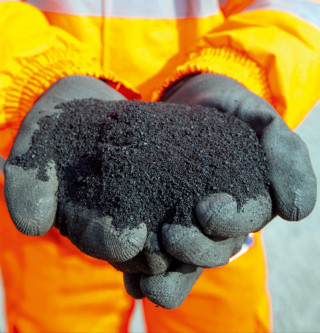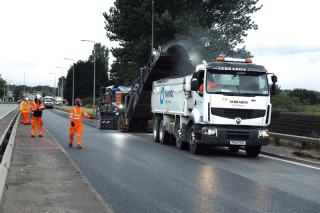If the news that rubber from recycled ‘end-of-life’ tyres can be used in asphalt mixes sounds familiar, that’s because it’s not really news at all.
Waste tyres have been processed for inclusion as an asphalt additive for many years – as early as the mid-1990s in fact. The state of California is believed to have been the first to approve its use; since then, rubberised asphalt has been widely used not only throughout the US, but also as far afield as South Africa, China and Malaysia.
But Tarmac’s announcement in June that it had become the first UK supplier to introduce a rubberised asphalt using recycled tyres was still considered a significant step forward – because the one country where rubberised asphalt has so far failed to catch on is the UK.
“There are three main reasons why the UK has been so slow to adopt this technology,” explains Brian Kent, Tarmac’s technical director, “and they are awareness, availability and economics.”
For some reason, people in the UK just aren’t fully aware of the scale of tyre waste or the possibility of recycling them, argues Kent. Consequently, low demand has meant that most waste tyres are exported.
Cost is another factor, says Kent: “In the US the early technique was what we call a ‘wet mix’ process in which the asphalt is supplied pre-blended. This is a very expensive process that requires investment in multi-million-pound equipment to shear the rubber into the bitumen.”

In the UK, nobody was prepared to take the plunge without first trialling the end-product, which meant importing it. “But we found that the rubber tends to separate out of these pre-blended mixes when it’s transported any distance,” says Kent.
By 2011, US suppliers started adopting a dry process, where the milled rubber ‘crumb’ is incorporated immediately prior to use. This is a more stable and much cheaper method; Tarmac began exploring its potential in 2013.
Besides the three factors cited by Kent, there was also the notoriously conservative nature of the UK road-building industry standing in the way of widespread UK acceptance. Roads authorities have traditionally adopted a prescriptive – rather than performance-based – approach to materials specification, making the introduction of new materials very difficult.
For UK advocates of rubberised asphalt, the turning point was the 2006 ban on the disposal of waste tyres to landfill under the terms of the Landfill (England and Wales) Regulations 2002. With approximately 40 million waste tyres produced in the UK every year, there was suddenly a lot of rubber with nowhere to go.
Brian Kent estimates that of these 40 million waste tyres around 12 million are still exported. But that figure is likely to come down. Peter Taylor, secretary general of trade body the Tyre Recovery Association, explains: “While there has been significant progress in reusing and recycling waste tyres in the UK, there is still an over-reliance on the export of used tyres to countries such as China, India and Pakistan, who are importing fewer tyres as they become self-sufficient.
“The UK needs a second disposal route for used tyres. Tarmac’s commitment to developing rubberised asphalt provides an excellent opportunity to achieve this and deliver environmental savings for this under-used waste stream.”
To incorporate waste rubber into an asphalt mix, the tyres first need to have fibre and steel reinforcement stripped out before the remaining rubber is reduced to a finely-milled crumb. This can then be incorporated directly into the asphalt mix.
Tarmac gets its crumb from Suffolk-based Murfitts Industries, which claims to the UK’s leading tyre recycling business. Murfitts processes around 11 million tyres every year, mainly for the manufacture of products such as artificial turf infill and playground mulch.

In terms of technology, Tarmac hasn’t had to invest in any multi-million-pound plant: the material just goes straight into the existing batching plant.
The company estimates that is will be possible to recycle and reuse up to 750 waste tyres for every kilometre of highway surfaced with the new material – depending on the thickness of the road. This would help to reduce the 120,000 tonnes of rubber waste exported from the UK annually, says Tarmac.
This is all great for the environment and recycling. But what does rubber crumb do for an asphalt mix? And is it worth the effort? “Absolutely,” declares Kent. “Rubber absorbs movement and it adds resilience.
“One of the problems in roads is reflective cracking, especially in cold weather,” he explains. Cracks allow water to penetrate the road surface; frost then starts to break up the asphalt and before you know it, you have potholes appearing in the road. And as everybody knows, the local road network is plagued with potholes.
According to Kent, adding rubber particles to the asphalt not only improves its resilience and flexibility: “The rubber particles in our asphalt can migrate to any voids in the surface which also makes rubber asphalt more waterproof.”
There are high-performance polymer-modified bitumen asphalts out there that can easily match Tarmac’s new rubberised material for flexibility and durability, admits Kent. But these are very expensive and cannot match rubberised asphalt for price.
“Our rubber mix is a mid-range option. It’s more expensive than the basic straight-run asphalt because shredding and milling waste tyres is a costly business. But it’s cheaper than the polymer-modified material, it’s more sustainable and it performs well,” says Kent.
Making use of a recycled material that would once have gone to landfill gives rubberised asphalt an environmental advantage, according to Kent. “And we’re seeing a growing appetite among local authorities for green and sustainable technologies,” he says.
Perhaps surprisingly, this is not the first time Tarmac has found a good use for waste tyres. The company – along with most other major manufacturers – has been using waste tyres as a fuel to fire its cement kilns for well over 20 years. Cement production remains one of the main markets for end-of-life tyres and the introduction of rubberised asphalt will help to boost Tarmac’s consumption of this recycled product.
Tarmac has conducted seven trials of the new material to test its performance. The first was conducted in Birmingham in 2011 and has since been followed by three trials on local roads in Coventry, one in Scotland, one in Whitley Bay and, in May this year, one for Highways England on a stretch of the M1 motorway near East Midlands Airport.
“We added more rubber for the Highways England trial because this is a heavily-trafficked road and we wanted it to be more resilient,” explains Kent.
So far, the tests have proved encouraging – all trial stretches are performing to the satisfaction of Tarmac’s clients. Rob Little, senior engineer at Coventry City Council’s highways department says he is ‘delighted’ with the product. “We hope we can use more of the product across the city in the future to help divert waste tyres from landfill and incineration.”
This article was first published in the July/August 2019 issue of The Construction Index magazine (magazine published online, 25th of each month.)
UK readers can have their own copy of the magazine, in real paper, posted through their letterbox each month by taking out an annual subscription for just £50 a year. Click for details.
Got a story? Email news@theconstructionindex.co.uk



